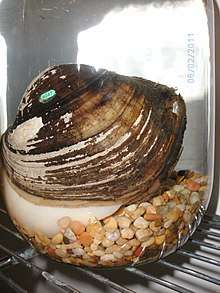Lampsilis cardium
Lampsilis cardium is a species of freshwater mussel in the family Unionidae, the river mussels. It is known commonly as the plain pocketbook.[2] It is widespread in eastern North America, where it is native to the Mississippi River and Great Lakes drainage systems.
| Lampsilis cardium | |
|---|---|
 | |
| Scientific classification | |
| Kingdom: | Animalia |
| Phylum: | Mollusca |
| Class: | Bivalvia |
| Order: | Unionida |
| Family: | Unionidae |
| Genus: | Lampsilis |
| Species: | L. cardium |
| Binomial name | |
| Lampsilis cardium Rafinesque, 1820 | |
Reproduction
All Unionidae are known to use the gills, fins, or skin of a host fish for nutrients during the larval glochidia stage. Lampsilis cardium accomplishes this by having the inner sides of its mantle flaps marked with longitudinal stripes, resembling a small fish of the genus Notropis. When these are attacked and ruptured by a striking predator fish, especially Micropterus coosae, the mussel larva is released into the gills of the host fish where it feeds and develops.[2][3]
References
- Bogan, A.E., Seddon, M.B. & Woolnough, D. 2017. Lampsilis cardium. The IUCN Red List of Threatened Species 2017: e.T11253A62905411. https://dx.doi.org/10.2305/IUCN.UK.2017-3.RLTS.T11253A62905411.en. Downloaded on 11 January 2019.
- Plain pocketbook, Lampsilis cardium. Unio Gallery. Missouri State University.
- Haag, Wendell R.; Warren Jr., Melvin L. (1999). "Mantle displays of freshwater mussels elicit attacks from fish". Freshwater Biology. 42: 35–40. doi:10.1046/j.1365-2427.1999.00454.x.
This article is issued from Wikipedia. The text is licensed under Creative Commons - Attribution - Sharealike. Additional terms may apply for the media files.
